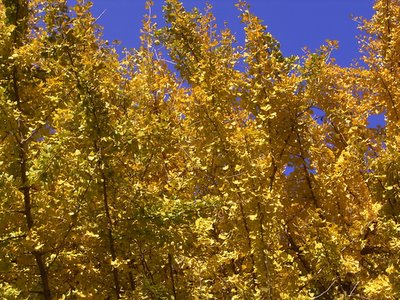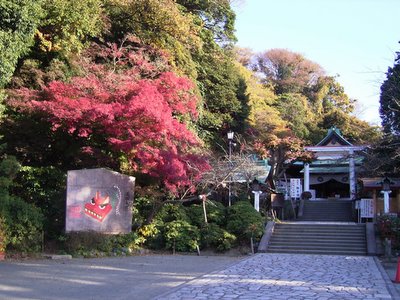
Japan has fabulous autumn colours and weather to match, so we walked in to the station one morning a few days ago and took a few photos on the way. This on the left is a ginkgo tree in someone's garden a few minutes down the road (with a typical autumn sky behind). The nuts can be roasted and eaten, and are often found at roadside stalls at this time of year. Curiously, the kanji in the Japanese name for the tree can be read as "gin" and "kyou" ("golden apricot") and the nut itself (which uses exactly the same kanji!) is called "ginnan" but the name "ginkgo" isn't understood here - they call the tree "ichou" instead. The brilliant golden leaves are among the first to change - in fact most have fallen now.

Our local bus-stop is beside the shrine Kamakura-gu, which has a good Japanese maple (momiji) outside. Before coming here, I used to think these trees were a miniaturized version of the larger Canadian equivalent. But here they grow into a fair size, albeit slowly. I suppose the ones in the UK are mostly young. Usually we get the bus from here, but it was so bright and sunny that we continued wandering through the back streets towards...

...
Hachiman-gu which is Kamakura's most important shrine, where millions (literally) of visitors come at the New Year (quite a sight - the whole town centre is closed to traffic, and the main street from the station is absolutely packed with people). Here's another momiji beside a bridge at one of the shrine's two ponds.
 Japan has fabulous autumn colours and weather to match, so we walked in to the station one morning a few days ago and took a few photos on the way. This on the left is a ginkgo tree in someone's garden a few minutes down the road (with a typical autumn sky behind). The nuts can be roasted and eaten, and are often found at roadside stalls at this time of year. Curiously, the kanji in the Japanese name for the tree can be read as "gin" and "kyou" ("golden apricot") and the nut itself (which uses exactly the same kanji!) is called "ginnan" but the name "ginkgo" isn't understood here - they call the tree "ichou" instead. The brilliant golden leaves are among the first to change - in fact most have fallen now.
Japan has fabulous autumn colours and weather to match, so we walked in to the station one morning a few days ago and took a few photos on the way. This on the left is a ginkgo tree in someone's garden a few minutes down the road (with a typical autumn sky behind). The nuts can be roasted and eaten, and are often found at roadside stalls at this time of year. Curiously, the kanji in the Japanese name for the tree can be read as "gin" and "kyou" ("golden apricot") and the nut itself (which uses exactly the same kanji!) is called "ginnan" but the name "ginkgo" isn't understood here - they call the tree "ichou" instead. The brilliant golden leaves are among the first to change - in fact most have fallen now. Our local bus-stop is beside the shrine Kamakura-gu, which has a good Japanese maple (momiji) outside. Before coming here, I used to think these trees were a miniaturized version of the larger Canadian equivalent. But here they grow into a fair size, albeit slowly. I suppose the ones in the UK are mostly young. Usually we get the bus from here, but it was so bright and sunny that we continued wandering through the back streets towards...
Our local bus-stop is beside the shrine Kamakura-gu, which has a good Japanese maple (momiji) outside. Before coming here, I used to think these trees were a miniaturized version of the larger Canadian equivalent. But here they grow into a fair size, albeit slowly. I suppose the ones in the UK are mostly young. Usually we get the bus from here, but it was so bright and sunny that we continued wandering through the back streets towards... ...Hachiman-gu which is Kamakura's most important shrine, where millions (literally) of visitors come at the New Year (quite a sight - the whole town centre is closed to traffic, and the main street from the station is absolutely packed with people). Here's another momiji beside a bridge at one of the shrine's two ponds.
...Hachiman-gu which is Kamakura's most important shrine, where millions (literally) of visitors come at the New Year (quite a sight - the whole town centre is closed to traffic, and the main street from the station is absolutely packed with people). Here's another momiji beside a bridge at one of the shrine's two ponds.
5 comments:
My mother has a ginkgo in her garden. But it never flowers or produces nuts :-( I fact it never goes that beautiful colour either...
Well that's one thing I might cross off the "I wish I was still in Japan" garden design if/when I return to the UK. The golden leaves are definitely a major part of the attraction.
You'll generally only find the males in public (yes they are dioecious gymnosperms), cos the fleshy seed coat is messy and smelly - it's only the kernel that is eaten.
A footnote about ginkgo. Excuse me for writing a long footnote again.
My knowledge about ginkgo was refleshed just one week before your posting, by a TV documentary (the "Spaceship Earth" series on TV Asahi on 27 Nov. -- a rare case when I am content with a TV program other than those of NHK.) The main story of the documentary was that ginkgo is a relic of mesozoic flora which co-evolved with dinosaurs. But it also discussed how people interacted with it.
Ginkgo is native in China, and imported to Japan probably around 1300.
The oldest evidence of ginkgo in Japan is several leaves sandwiched in notebooks one of which has a date of 1318, which are preserved in a historical archive Kanazawa Bunko (quite near where we live; a railway station nearby is named after it). It is said that the leaves were used as bug-repellent.
Kamakura's Hachiman-gu shrine has a famous ginkgo tree, which is said to have been part of the stage of an assassination in 1219. But scientific investigation revealed that the tree is about 500 years old.
An older tree exists in Aomori Prefecture, but its age is not yet certain.
We call the tree "icho" (with long "o"), and its nuts "ginnan". The same sequence of two chinese characters are used to mean either, and some literate people think that the "proper" reading of the sequence is "ginkyo" (with long "o"). Modern Chinese uses the same sequence which is pronounced "yin-xing". (Modern Chinese "xi" sounds like the word "she" in English.) Classic Chinese texts were systematically introduced to Japan (also to Korea and Vietnam) around the 8-9th centuries with then standard pronunciation. The two characters would have been pronounced approximately "ngin-hyong", and subsequent evolution of the sounds in Japanese results in "gin-kyo". "Ginnan" is "gin"+"an", and "an" is an irregular reading which probably came from southern China in 11th century or later (approximate sound there would be "ang"). It is likely that ginkgo came together with a pronunciation like "ginnan", and "ginkyo" may just be a reading (re-)constructed by scholars.
The etymology of "icho" is controvertial, but the most likely story is that it came from the modern chinese word "ya-jiao" which literally means "duck legs" but sometimes used as a nickname to the plant.
The Western name "ginkgo" is probably a misprint perpetuated. It is found in a book published in 1712 by Engelbert Kaempfer, a German medical doctor and naturalist who had accompanied Dutch traders to Nagasaki. He described many plants found in Japan, and "Ginkgo" was among them. Given his German and Dutch backgrounds, it is likely (to me) that the spelling he intended was "Ginkjo", corresponding to "ginkyo" in my spelling. It was not corrected because the communication rate between Europe and Japan was very low -- just one Dutch ship per a few years! By the time when Japan enlarged the communication channel (in 1850s), the Western name had evolved its own way. In 1771 Linne adopted the name as its botanical name (Ginkgo biloba), and in the early 19th century Goethe made the plant popular.
Masuda's brief essay is fascinating. I would make just one correction: "ya jiao" 鴨腳 means "duck foot," not "duck leg." Makes sense, right?
Good catch. In Japanese, the same word (ashi) is used for both foot and leg.
Post a Comment